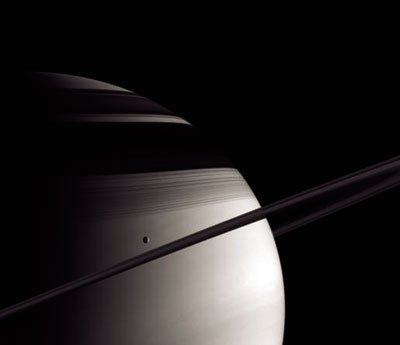The first giant to show off this month is Saturn, continuing to
glow prominently all night in the long winter nights, with giant
Jupiter rising a couple hours after midnight.
The first giant to show off this month is Saturn, continuing to glow prominently all night in the long winter nights, with giant Jupiter rising a couple hours after midnight. If not for the Moon and Venus, Jupiter would be the brightest object in the night sky.
And that is saying something when you consider the fact that the winter skies contain the most brilliant stars of the year. Saturn, certainly not the brightest, can hold its own in beauty especially when observed through higher magnification.
Saturn’s rings are arguably the best telescopic view in the heavens. This year we see the rings tilted toward us at 15 degrees from edge on, showing off it’s somewhat fading southern face. Saturn’s rings are closing more each year, and by 2009 they will appear edge-on. All you will see is a fine line at the equator.
Then slowly the northern half of the planet will start to show it’s face, and then it starts all over again. Unfortunately a lot of us old boys won’t be around to witness another series, but you younger guys have many stargazing years left in you. Don’t squander them away. Get out there at night and look up, enjoy the skies before you are one of those old boys yourself.
Look up toward the sunset this month and you just can’t miss Venus shining as bright as she can. This second planet from the Sun lingers two hours at the first of the month before it sinks below the horizon, and by the end of the month it will last for over two and a half hours.
Constellation of the Month: As we mentioned, the winter sky sparkles with bright stars. Does it just seem this way because of the clear frosty air?
No, the winter sky is just full of bright stars. Earlier we learned about many of these stars in the constellation Orion. This month we learn about a less conspicuous but still, nun the less, a well known constellation, Gemini.
To find Gemini, just draw a line from the two brightest stars in Orion (Betelgeuse and Rigel) and go east. It will point right at Gemini. You will see two vary bright stars, Castor and Pollux. Gemini is the Latin word for “twins.”
The two stars are the heads of the twins, and their bodies are the two ragged lines of stars sloping down to their feet, which stand on the Milky Way. Pollux is just a little brighter, and is slightly orange in color.
In your telescope, Castor is one of the many double stars in the sky. It actually is a group of six stars close together.
Castor and Pollux were famous twin brothers in Greek legends. Castor was a wrestler and Pollux was a boxer, and together they went on many adventures. There was hardly any difference between them, except that Castor was mortal and Pollux was immortal.
When Castor was killed, Pollux was so sad that he wanted to die too, but he could not. The gods were so impressed by their brotherly love that they let them live together in the sky forever.
I don’t know if I would want to be in the sky with my brother forever. I like to think that I could come up with someone better to spend the rest of time with.
To my liking I just received a new mount for my telescope. They are right when they say, “The only difference between boys and men is that their toys get more expensive when you get older.”
It just feels nice to see that I can still get excited about my hobby. I thought I had lost that ability to stand by the mailbox everyday wondering if it is going to arrive today or not. It never seems to arrive soon enough.
Clear skies.
David Baumgartner is in local real estate and is an avid amateur astronomer. His Sky Watch column appears monthly.














